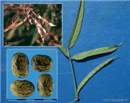Scientific name(s)
Centrosema pascuorum
Strengths
- Well adapted to semi-arid environments
- Tolerant of waterlogging
- High yielding
- High seed yield
- Palatable
- High quality
Limitations
- Annual
- Not tolerant of continuous grazing
- Slow to form a competitive sward
- Build up in disease with successive crops
Plant description
Plant: Annual prostrate and twining legume.
Stems: Up to 2 m long. May be hairy. Roots at the nodes under favourable conditions.
Leaves: Comprise three leaflets, green to dark green, often held erect. Linear-lanceolate, commonly 5 -10 cm long and 0.5- 1 cm wide.
Flowers: Crimson or wine red in colour, 1.5 - 2.5 cm in diameter.
Pods: Mature 3.5 - 7.0 cm long, including an awn, and 3 -4 mm wide. Contain up to 15 seeds. Pods shatter explosively when mature, scattering seeds up to 1 metre.
Seeds: Ovoid to cylindrical, approximately 4 mm long, grey - green in colour. Approximately 48,000 or 58,000 seeds/kg.
Pasture type and use
Best suited as a hay crop or a short term ley pasture. Useful as a pioneer species in pasture mixes and as a standover feed.
Where it grows
Rainfall
700 - 1500mm/year in tropical with distinct wet and dry seasons. Suited to areas with a dry season of 6 - 8 months.
Soils
Adapted to a wide range of soil types, but does best on well drained clay loams. It tolerates periods of drought during the wet season. Survives prolonged waterlogging and occasional submersion on seasonally flooded soils.
Temperature
Well adapted to the semi-arid tropics. Not well-suited to the subtropics.
Establishment
Companion species
Can be sown with signal grass, pangola grass, buffel grass, guinea grass, setaria, sabi grass or tall finger grass
Sowing/planting rates as single species
2 -6 kg/ha depending on seed bed preparation and proposed end use.10 - 15 kg/ha when sown as an annual hay crop.
Sowing/planting rates in mixtures
2 - 6 kg/ha
Sowing time
Early in the wet season after good opening rains, when there is likelihood of follow up rains. This will range from the first week of December in higher rainfall areas (1500 mm) to the first week of January in lower rainfall areas (700 mm).
Inoculation
Seed can be inoculated with Centro inoculant to ensure nodulation when sowing into new areas. This is not necessary if legumes have been grown in the area previously, or if there are native legumes present.
Fertiliser
Prefers more fertile soils. Responds strongly to phosphorus and sulphur. Generally apply 100 - 250 kg/ha of superphosphate or its equivalent at establishment. Applications of potassium, molybdenum, zinc or other deficient elements may be necessary on some soils.
Management
Maintenance fertliser
Generally apply 50 - 100 kg/ha of superphosphate or its equivalent.
Grazing/cutting
Do not graze in the year of establishment before it has set seed. It tends to die out in continuously grazed mixed pastures.
It is generally not cut for hay before Easter because of the risk of rain on the full moon.
Seed production
Commercial seed yields up to 1,000 kg/ha have been recorded. Seed can be harvested by direct heading of windrowed seed crop or by suction harvesting of shed seed. First flowers appear late March or late April. Seed crops are generally harvested in June or July. Freshly harvested seed can have a hard seed content as high as 90 %. Scarification generally leads to seed with a germination of approximately 60 %.
Ability to spread
Poor in comparison with other tropical legumes. Plants will spread vegetatively up to 2 m. Seed can be spread up to 1 m by splitting pods. Some disturbance, such as a rough cultivation is the minimum requirement to ensure establishment.
Weed potential
Negligible. Evaluated with a low weed risk by the Northern Territory Weed Risk Assessment method.
Major pests
Seed feeding insects such as pod sucking bugs and pod borers can cause almost total loss of a seed crop.
Major diseases
None recorded to date. Larger patches of leaves killed by Rhizoctonia sp have been found in commercial hay crops after a number of consecutive crops in the same area.
Herbicide susceptibility
Selective control of grass weeds and some broadleaves: tolerant of Spinnaker®, Sertin® and Verdict
Cultivar Cavalcade is extremely susceptible to the insecticide, Carbaryl.
Animal production
Feeding value
High compared to other herbaceous tropical legumes used in the semi-arid tropics. Crude protein (CP) of tops during the wet season (January - March) often 18 - 20%. Good hay is 12- 14 % CP. In vitro digestibility of tops can be 79 %, but is more commonly 65 - 70 %.
It can maintain its high quality during the dry season because it retains most of the dead leaves on the stems.
Palatability
In the semi-arid tropics, it is highly palatable to grazing ruminants and horses as standing feed or hay.
Production potential
In pure swards under good growing conditions, it provides 4 -6 tonnes/ha of high quality herbage. Under ideal conditions, up to 8 tonnes/ha of herbage is produced. Yields of over 10 tonnes/ha have been reported from some commercial hay crops.
Livestock disorders/toxicity
None reported.
Cultivars
| Cultivar | Seed source/Information |
| Bundey | Public variety. Has hairy stems, flowers in late April, 1 month later than Cavalcade, seeds 58,000/kg, produces up to 800 kg seed/ha. |
| Cavalcade | Public variety. Stems not hairy, flowers late March, seeds 48,000/kg, produces up to 1,000 kg seed/ha. |
Further information
Tropical Forages database (SoFT) - Centurion
Northern Territory DPIFM - Agnote E20 (Bundey)
Northern Territory DPIFM - Agnote E14 (Cavalcade)
Acknowledgements
-
Author and date
Arthur Cameron
April 2009




